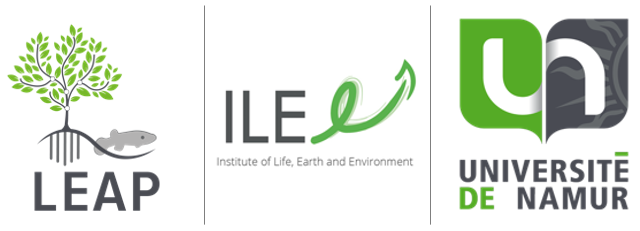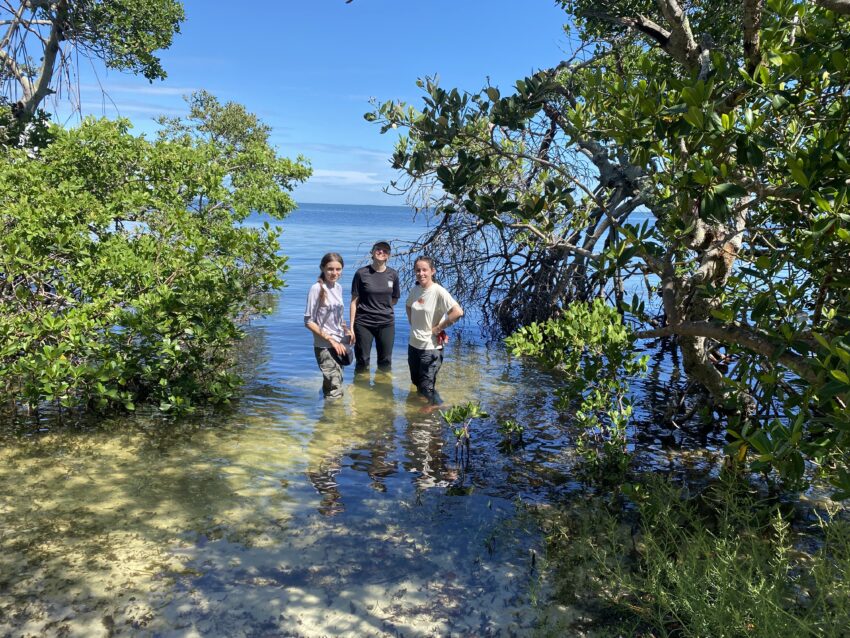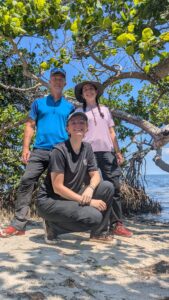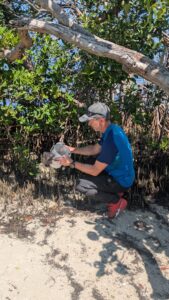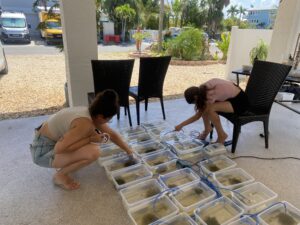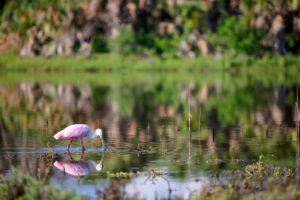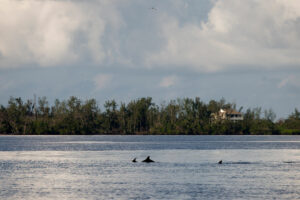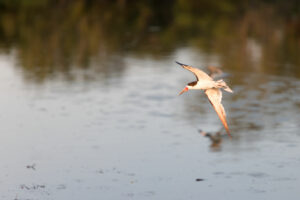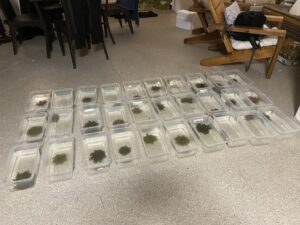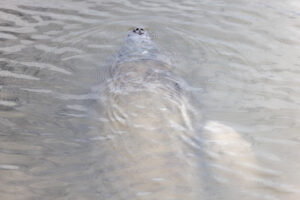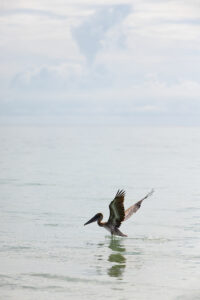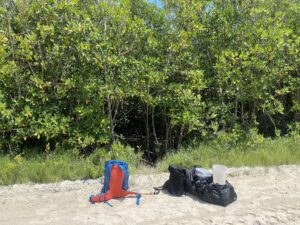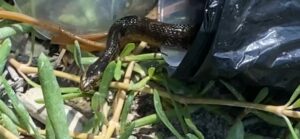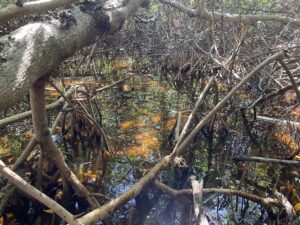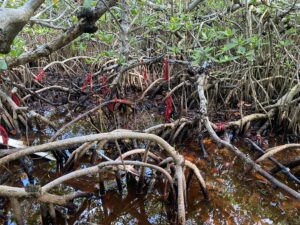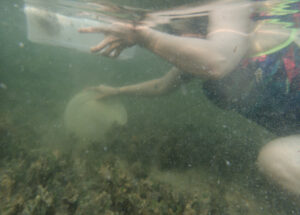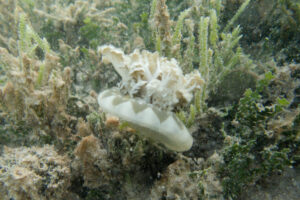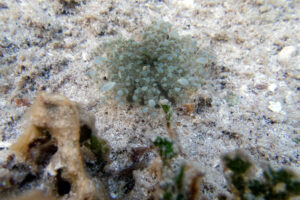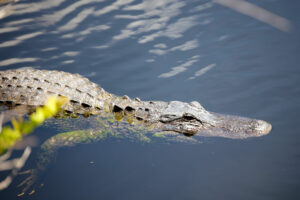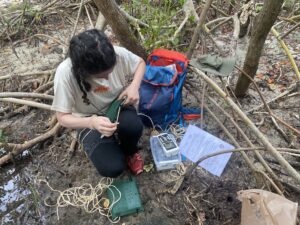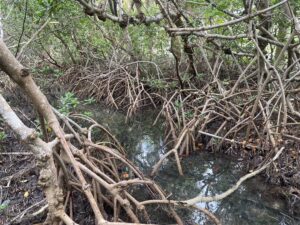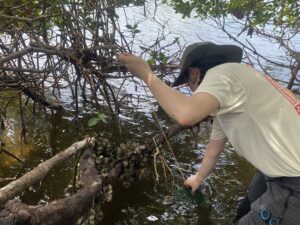Scientific Mission to South Florida - Epigenetics and Environmental Stress in Mangrove Rivulus and Cassiopea Jellyfish - July-August 2025
From July 16 to August 6, 2025, members of the Research Unit in Environmental and Evolutionary Biology (URBE) undertook a field expedition to South Florida, focusing on the study of two mangrove model species: the self-fertilizing mangrove rivulus fish (Kryptolebias marmoratus) and the upside-down jellyfish (Cassiopea sp.). The mission was led by Prof. Frédéric Silvestre, accompanied by Dr. Noëmie Guirandy (postdoctoral researcher), Justine Bélik (teaching assistant and PhD student), and Noémie Buratto (teaching assistant and PhD student, under the supervision of Prof. Eli Thoré and Dr. Omayma Missawi). We had also the opportunity to have the help of a young student from Philadelphia, Mme Sofia Viatour, who made an internship with our team to gain experience in field marine biology and prepare her applications to college. Following an initial flight cancellation due to severe weather in New York, the team arrived on July 16 and carried out extensive sampling and behavioral testing across multiple mangrove ecosystems.
The mangrove rivulus is an emerging model for studying the interplay between epigenetics, environmental stress, and adaptation, particularly due to its unique reproductive biology (self-fertilizing hermaphrodites) and naturally isogenic populations. This makes it an ideal organism for investigating how environmental factors can shape behavior and gene regulation without confounding genetic variability. One of the focal populations, located at Emerson Point Preserve (EPP) near Tampa Bay, is among the most genetically homogeneous.
In parallel, the Cassiopea jellyfish, a benthic cnidarian commonly found on mangrove seafloors, serves as a promising sentinel species for monitoring marine pollution, including microplastic contamination.
The field mission fulfilled its four main research objectives:
- Behavioral and Epigenetic Study of Mangrove Rivulus (J. Bélik)
-
Collect 40+ hermaphroditic individuals from Emerson Point Preserve.
-
Conduct triplicate behavioral tests (shelter emergence assay).
-
Sample brain and liver tissues for longitudinal DNA methylation analysis, to compare with samples from 2023.
-
- Multisite Environmental Epigenetics (N. Guirandy)
-
Sample K. marmoratus from four ecologically distinct sites: Emerson Point, Fort De Soto, Long Key, and Vero Beach.
-
Dissect brain, gonads, and fins for biomarker development.
-
Deploy passive samplers (HLB cartridges) at each site to screen for pollutants (e.g., hormones, pesticides).
-
- Cassiopea Jellyfish Survey (N. Buratto)
-
Locate and collect ~30 jellyfish specimens.
-
Perform 72-hour behavioral stress tests under controlled conditions.
-
Preserve and ship 15 specimens to Belgium for microplastic content analysis.
-
- Epigenetic Age Estimation
- Collect fin clips across all fish populations to apply a recently developed epigenetic clock for age estimation.
Between July 17 and 22, the team visited all four target sites across South Florida, deploying passive sampling cartridges and trapping K. marmoratus in mangrove zones at the edge of red and black mangrove roots. The passive samplers were installed for two weeks in shallow, slow-flowing waters to optimize exposure to environmental contaminants. Collected fish were temporarily housed and dissected under controlled conditions. Tissues were preserved for later molecular analysis. Physicochemical parameters (e.g., temperature, salinity, pH) were recorded at each site using a multiprobe.
Cassiopea surveys were conducted by snorkeling at Emerson Point, Fort De Soto, and Long Key. A usable population was found at Fort de Soto, from which 30 jellyfish were successfully collected. Some behavioral data could be obtained from short-term assays.
Moreover, between July 23 and 28, the team returned to Emerson Point and Fort De Soto for additional fish sampling. In total, 52 rivulus individuals were captured at Emerson Point, and 44 underwent boldness testing using a standardized shelter test performed in triplicate. The behavioral setup involved a 15-minute acclimation phase followed by 30-minute video-recorded trials, from which key behavioral metrics (e.g., latency to emerge, movement patterns) will be extracted back in Belgium.
The mission yielded a rich dataset of behavioral recordings, tissue samples, pollutant exposure profiles, and jellyfish specimens. These materials will support several ongoing projects at UNamur in the domains of environmental epigenetics, pollution biomonitoring, and behavioral ecology.
The work is part of a broader effort to understand how organisms in fragile coastal ecosystems respond to anthropogenic pressures, and how epigenetic mechanisms might mediate adaptive responses in genetically constrained species like the mangrove rivulus.
We thank our local partners and field collaborators in Florida, mostly Dr Ryan Earley, for their support and access to research sites. We are also grateful to our funding partners, which made this work possible: FNRS, ILEE, UNamur, the Royal Belgian Zoological Society.
Sharing is caring!
